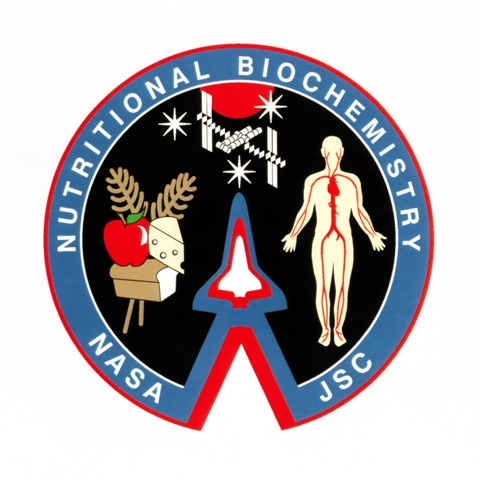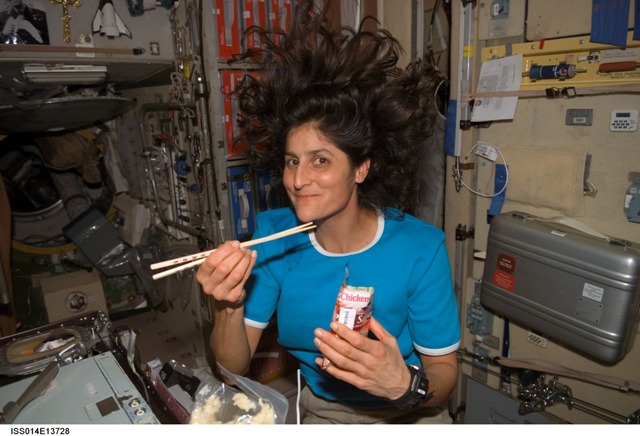This week, comments from guest blogger Dr. Scott M. Smith as he reflects on recent space station research, which connects a diet rich in fish intake and omega-3 fatty acids to a reduced rate of bone loss.
Scientists spend a lot of time discussing their work in proposals, manuscripts, and meetings, but Eureka! or light-bulb-going-off moments are amazingly rare. Our Nutritional Biochemistry Lab at NASA Johnson Space Center, however, was fortunate enough to have one of these moments recently.
Our lab’s Eureka! moment actually started a few years ago when we submitted a proposal to look at omega-3 fatty acids as a countermeasure for the muscle loss caused by space flight. Omega-3 fatty acids have been shown to help stop muscle loss in cancer patients; we believed the sub-cellular mechanisms of the two types of muscle loss are similar. In theory, if it works for cancer, it should work for space travelers. Although that proposal was well scored, funding was short that year and our experiment did not make the cut.

NASA Johnson Space Center Nutritional
Biochemistry Lab Logo
Image courtesy of NASA
The data suggesting that omega-3 fatty acids would help slow or stop muscle loss was pretty convincing, but some softer evidence hinted that omega-3 fatty acids might also help slow bone loss. We proceeded to do a cell culture study—long story short, we added omega-3 fatty acids to bone cells and it suppressed the activation of cells that break down bone; bone breakdown is the process that is accelerated during spaceflight and during disuse here on Earth. This was pretty exciting in and of itself, but not the moment of epiphany.
The Eureka! came when we were in a meeting reviewing another bone loss countermeasure that was tested during bed rest. Unfortunately, despite high hopes going into the study, this method was not working. As I rolled this around in my head, it seemed to me that nothing to date had worked at slowing bone loss. We had tried exercise and other physical countermeasures with limited success and, although drugs are available, there is not a drug out there without side effects.
It was during this reflection that the light bulb went on. Eureka! I realized that our bed rest studies had included a menu that was pretty loaded with fish, which is a great source of omega-3 fatty acids. This was done to help increase the vitamin D content of the diet, a very important factor. As I thought of ways to investigate my hypothesis, I realized I had some challenges to face in gaining specific data on omega-3 fatty acid intake. It is not easy to find volunteers to literally spend a few months in bed, let alone subjects who are willing to participate in the bed rest and also forego eating fish.
Driving home that night, I called my colleague Dr. Sara Zwart and suggested we look at the omega-3 fatty acid intake in the existing bed rest subjects and compare it to the bone data from the same subjects. The next morning, Sara had the graph, which clearly showed a relationship between omega-3 fatty acids and N-telopeptide—a marker of bone breakdown that appears in the urine. Specifically, and statistically significantly, the more omega-3 fatty acids the subjects ate, the less bone breakdown marker they excreted, which was pretty cool!
We then took the next logical step, to see if the diet of astronauts was related to their bone breakdown. We track dietary intake of astronauts during space flight using a food frequency questionnaire or FFQ. This tool monitors the intake of seven key nutrients: energy, fluid, protein, calcium, iron, sodium, potassium. The FFQ is designed to measure only these specific things, so if we wanted to measure anything else, we would typically have to modify how we grouped the foods in the questionnaire.
Instead of redesigning the tool, we took a leap and looked at fish intake in the diet of the International Space Station crewmembers. Given that we did not have the detailed omega-3 fatty acid content of all space station foods, and given that we did not sort out the fish by those rich or poor in omega-3 fatty acid content, this was admittedly a stretch. When we compared the relationship between reported fish intake in crewmembers and their bone loss after flight, however, we found another significant relationship. Those who ate more fish lost less bone. This was awesome stuff! It was one of those rare times in a scientist’s career when unrelated pieces of information actually built into a complete story.
This story did not end, though, with these findings. What we had at this stage was what is called correlational evidence. The two factors—fish intake and bone loss—were related. This does not directly prove a causal relationship, however, and could be nothing more than coincidence or indirect effect. For example, those who ate more fish probably ate less meat, which we also conjecture is bad for bone health. What we need now is a controlled study, where we track and control intakes throughout a space mission, with one group eating a high omega-3 fatty acid diet and others consuming a low or “control” omega-3 diet. By comparing the data from such a study, we can detect differences in bone loss. We have submitted this proposal and hope an opportunity arises in the near future to carry out the experiment.
This research not only has clear benefits for astronauts, but also significant implications for those of us on Earth. These types of relationships—between fish and bone—have been observed. Given the much slower rate of bone loss on Earth, however, makes effects more difficult to pinpoint. Microgravity research can amplify the impacts, providing new knowledge that may benefit those suffering from bone loss. This is just another example of where the space station provides an out-of-this-world platform for human research!

Astronaut Suni Williams eats a meal that includes salmon, a fish rich in omega-3 fatty acids,
while on orbit aboard the International Space Station.
Image courtesy of NASA: ISS014E13728
Dr. Scott Smith and his colleague Dr. Sara Zwart lead NASA’s Nutritional Biochemistry Lab at Johnson Space Center. The research discussed above was published in the Journal of Bone and Mineral Research (Volume 25, pages 1,049-57, 2010). In addition to ground-research studies, they lead two space station experiments: Nutritional Status Assessment and Pro K, which investigate the roles of animal protein and potassium in mitigating bone loss. In today’s blog Dr. Smith shares his thoughts and experiences as a scientist with the readers of A Lab Aloft.

Dear Scott,
Nice article! Can you tell me about any past statistically significant Earth-bound studies of normal-life folks that relate Omega-3 fatty acids to bone loss?
Thanks!
J-D
(Posted on behalf of Dr. Scott Smith)
J-D,
Thanks for the comment and question. Indeed, studies on the ground have identified similar, statistically significant, findings in humans. For one example, Griel and colleagues (1) performed a controlled feeding study in humans and found that plant sources of omega-3 fatty acids decrease markers of bone resorption after 6 weeks. They also found that the markers of bone resorption were positively correlated with TNFα, suggesting that omega-3 fatty acids may be acting by decreasing NFB activation (i.e., the same thing we found to be elevated in astronauts after shuttle missions). Other human studies have found that a higher concentration of omega-3 fatty acids in serum is related to a higher bone mineral density in young men (2).
Not only does loss of bone mineral decrease bone strength and density, it also increases renal stone risk (3). Given the supporting literature for a beneficial effect of omega-3 fatty acids on bone (1, 2, 4, 5), it is no surprise that it also has been documented to reduce risk of kidney stone formation. In several studies, omega-3 fatty acids given to recurrent kidney stone formers decreased urinary calcium and stone incidence in human (6, 7) and animal studies (8, 9).
1. Griel AE, Kris-Etherton PM, Hilpert KF, Zhao G, West SG, Corwin RL. An increase in dietary n-3 fatty acids decreases a marker of bone resorption in humans. Nutr J 2007;6:2-10.
2. Hogstrom M, Nordstrom P, Nordstrom A. n-3 Fatty acids are positively associated with peak bone mineral density and bone accrual in healthy men: the NO2 Study. Am. J. Clin. Nutr. 2007;85:803-7.
3. Whitson PA, Pietrzyk RA, Morukov BV, Sams CF. The risk of renal stone formation during and after long duration space flight. Nephron 2001;89:264-70.
4. Vanek C, Connor WE. Do n-3 fatty acids prevent osteoporosis? Am. J. Clin. Nutr. 2007;85:647-8.
5. Heaney RP, Carey R, Harkness L. Roles of vitamin D, n-3 polyunsaturated fatty acid, and soy isoflavones in bone health. J. Am. Diet. Assoc. 2005;105:1700-2.
6. Buck AC, Davies RL, Harrison T. The protective role of eicosapentaenoic acid [EPA] in the pathogenesis of nephrolithiasis. J. Urol. 1991;146:188-94.
7. Yasui T, Suzuki S, Itoh Y, Tozawa K, Tokudome S, Kohri K. Eicosapentaenoic acid has a preventive effect on the recurrence of nephrolithiasis. Urol. Int. 2008;81:135-8.
8. Tulloch I, Smellie WS, Buck AC. Evening primrose oil reduces urinary calcium excretion in both normal and hypercalciuric rats. Urol. Res. 1994;22:227-30.
9. Lenin M, Thiagarajan A, Nagaraj M, Varalakshmi P. Attenuation of oxalate-induced nephrotoxicity by eicosapentaenoate-lipoate (EPA-LA) derivative in experimental rat model. Prostaglandins Leukot. Essent. Fatty Acids 2001;65:265-70.
Scott,
Good to read about your continuing research. Sounds like a good reason for us to eat fish!
JVF
Obviously we don’t want to damage the equipment but I am left wondering if there is a way to use a version of a vibraflex to increase bone density/fight bone loss.
I’m throwing a link up for any fitness buff who wants
to read more about vibration plates and bone density and hopefully it will be here for a bit. Although I’m not sure if you can but I will give it a try:
A vibration plate as a countermeasure for bone loss has been tested in bed rest subjects before being considered for an ISS flight experiment.
http://hacd.jsc.nasa.gov/projects/flight_analogs_pastpresent5.cfm
Results are starting to publish.
http://bit.ly/hEvlLz
Hello Scott, This is a great read. I have heard of Omega-3 fatty acids. But have you heard of Cissus Quadrangularis. It really can have big impact on human bones.
Very nice layout and good articles, nothing at all else we want :D.
I haven’t really figured out drag-drop yet… but this post is very worthwhile. Thanks for posting it!
Thanks
From Team
Omega 3 is good for so many health benefits. I would bet that the N-telopeptide they were measuring – has something to do with inflammation. Omega 3 has many health benenfits but I think it’s best health quality is it’s anti inflammatory properties. ALmost all of our disease of today rise form inflammation. SO do you health a favor and increase your omega 3 levels.
can someone help me to discover more details about how to find a way to having a great Flaxseed oil vegetarian with omega 3 nutrition dishes ?
This is a great read. I have heard of Omega-3 fatty acids. But have you heard of Cissus Quadrangularis.